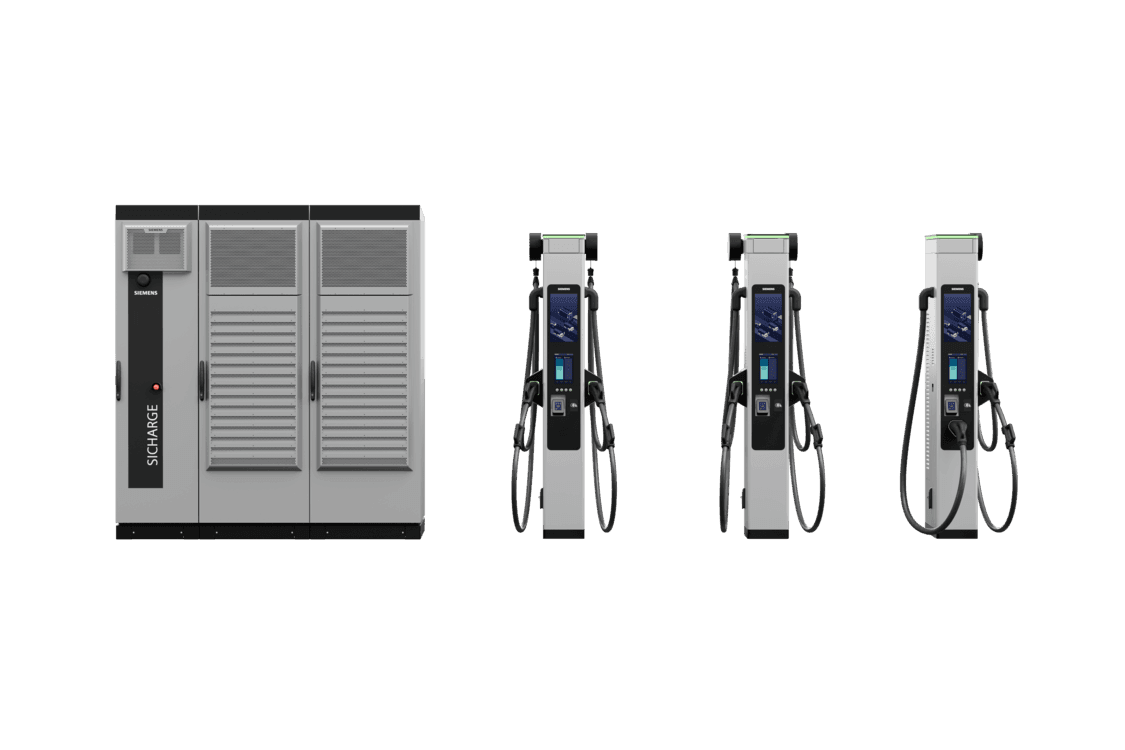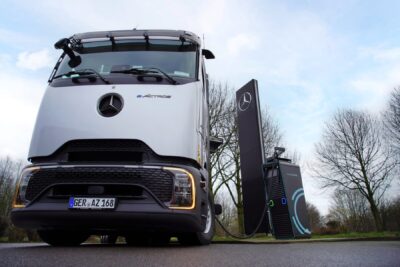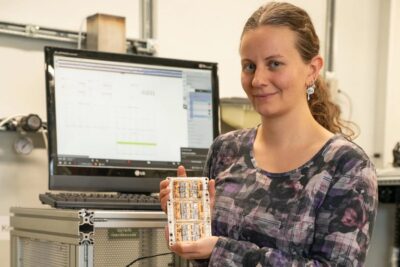Siemens introduces Sicharge Flex megawatt charging system
Under the name Sicharge D, Siemens introduced a fast-charging station in 2021 that achieved a charging capacity of up to 300 kW. In 2024, the charging capacity was increased to 400 kW. Customers using the device include E.ON and Leipziger Stadtwerke, as well as OMV and the Raiffeisen energy cooperatives in Austria.
Now, at Busworld, Siemens has introduced a new version of Sicharge called Sicharge Flex. The name comes from the fact that the system can be flexibly adapted to its location. Important to understand: Sicharge Flex is a decentralised charging system consisting of a control cabinet including a power supply unit and one or more dispensers. It is also decentralised because the dispensers can be located up to 300 metres away from the control cabinet.
Higher peak power than other MCS chargers
So much for a brief overview of the basic structure of the system – but the technical data is, of course, even more exciting. The cabinet is available in three sizes and can deliver an output of 480 kW to 1.68 megawatts at a current of 1,500 A. This means that the system is significantly more powerful in the megawatt range than the first megawatt products from competitors: Alpitronic’s HYC1000 delivers exactly one megawatt, ABB’s MCS charging station, which has just been inaugurated in the HoLa project, delivers 1.2 megawatts, as does Kempower’s, while the MCS charger from Power Electronics used by Milence delivers 1.44 megawatts.
“The introduction of SICHARGE FLEX marks a significant milestone in our journey to build a comprehensive and sustainable E-Mobility ecosystem,” said Markus Mildner, CEO eMobility, Siemens Smart Infrastructure. “”This solution embodies our vision for a future where EV charging is not only fast and reliable, but also seamlessly integrated and highly efficient. SICHARGE FLEX empowers our customers to confidently scale their operations, optimize energy use, and contribute to a cleaner, more electrified world.”
However, in order to achieve the maximum charging capacity of the Sicharge Flex of 1.68 megawatts for a single vehicle, many factors must be in place, and this does not appear to be the primary objective of the product: it starts with the grid connection, which must be capable of supporting such a high power output in the first place. Furthermore, there are still very few vehicles with MCS connections, let alone those with such high charging power: the highest charging power achieved in a real-world test to date is 1.14 megawatts in a trial by Designwerk. And it is important to note that MCS is currently only intended for electric trucks and buses, which often have huge battery systems in the range of 500 kWh and above and take a relatively long time to charge using CCS chargers.
This means that the Sicharge Flex is a product that is likely to be future-proof for several years. Another factor to consider when it comes to achieving maximum charging power is whether and how many vehicles have to share it. This is because if the maximum charging power of 1.68 megawatts is to be provided for a single vehicle, no other vehicles can be charged at the same time.
Up to four MCS charging points
The system consists of a control cabinet with a power supply unit and one or more dispensers. The Sicharge Flex features a fully dynamic energy distribution system that intelligently distributes the power to several charging points according to the real-time requirements of the vehicles. This system offers the aforementioned power range from 480 kW to 1.68 megawatts. The individual charging stations can thus supply power in 80/120 kW increments. This is intended to enable optimum and efficient power delivery. As mentioned, both the CCS and MCS charging standards are supported.
Six CCS charging points or four MCS charging points can be installed in a single system – or a combination of both. Combining a CCS and MCS charging point at a single dispenser is also possible. In this case, however, only one of the two plugs can be used at a time, and the other plug is blocked during charging. Siemens refers to this as “dual-plug, single-use.” Siemens will later expand its offerings and also offer systems with 12 or 18 CCS charging points.
Back to the up to four MCS charging points: Given the total available power of 1.68 megawatts, this would mean that if all four MCS charging points were in use, only 420 kW per vehicle would be available, unless the load is distributed differently. But of course, this is a similar process to conventional CCS charging stations: there, all charging points are rarely used to full capacity, so that one vehicle can often receive the maximum power. However, this can be a critical factor for the target group of truck drivers, because the charging break must be easily calculable and fit in with the driver’s legally prescribed breaks.
OMV petrol station in Kufstein gets Sicharge Flex
Siemens plans to launch Sicharge Flex on the market next year. The first customer has already been secured: Austrian oil company OMV plans to install Sicharge Flex at a petrol station in Kufstein, along the A12 corridor connecting Germany and Italy. The site will be designed for electric cars as well as electric trucks and buses. In the first phase, six charging points will be installed, with an expansion to ten charging points planned after the local distribution network operator has reinforced the grid.
“At OMV, our mission is to provide our customers with reliable, high-performance
charging infrastructure that meets the demands of modern mobility – today and
tomorrow,” says Eric Schulze, Senior Vice President Retail Mobility & Convenience, OMV. “The new site in Kufstein is a prime example of how we combine strategic location planning with cutting-edge technology to deliver real value: fast charging for eTrucks, eBuses and passenger cars, seamless user experience, and future-ready scalability.”
Source: Info via email
This article was first published by Florian Treiß for electrive’s German edition





1 Comment